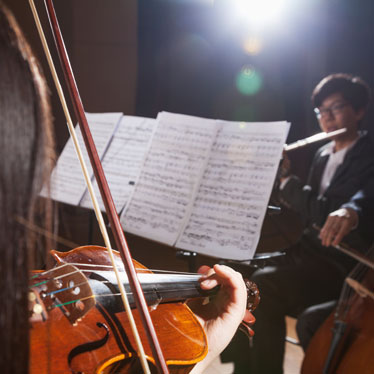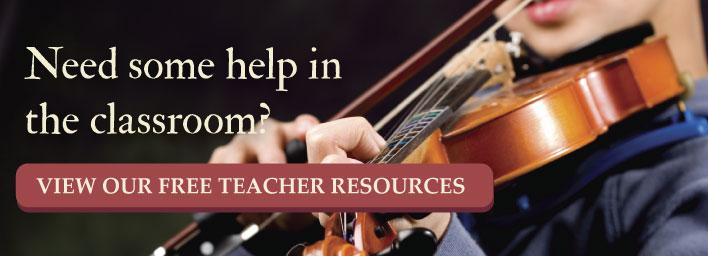How To Calm Your Music Students’ Performance Anxiety

As a music teacher, you’ll encounter everything from students who casually walk on stage, barely adhering to the concert dress code, and pull off magnificent performances to students so scared they tremble, get sick or flat-out refuse to perform altogether. Fortunately, there are things you can do to calm music students’ performance anxiety.
Some of the tips and tricks we’ll cover address immediate, pre-concert jitters. Ideally, teaching students how to manage stress and anxiety should be an integrated part of your music program. By addressing stress and anxiety throughout the year, you can keep overall anxiety to lower-levels, and the tools students cultivate daily will then transfer to performances.
The fast track for putting the brakes on concert nerves
Since the holiday concert season is gearing up, we’ll start with some fast-track tips for helping nervous students calm down. Afterward, we’ll offer tips for building anxiety prevention into the curriculum.
Take advantage of apps
We often share the latest apps for string musicians. Now, we’ll share the latest apps for mindfulness and meditation. Some of the exercises you’ll use to de-escalate anxiety can be done as a group, but some students may prefer to find their own private means of calming their nerves.
There are many meditation apps out there, but you can introduce these 10 Meditation Apps…, from PC Mag, to get them started. The ability to use their headphones, their phone, and have eyes closed may be more soothing for some students than group relaxation exercises. Plus, these apps are something they can have with them at the ready, whether they’re nervous for a big exam, a sports event, preparing for attending a university – or before your concert.
Deep breathing
There isn’t a stress reduction class in the world that skips over the remarkable power of deep, slow breaths. Physiologically speaking, slowing and deepening the breath goes a long way towards slowing the heart, which can get the body out of “fight or flight” mode.
Biochemically speaking, deep breathing changes the cellular biochemistry of the brain and gets more oxygen to the cells, which restores critical thinking skills. Some breathing exercises work better for people than others, so take some time to share the three different breathing exercises explained in this Stress Management article from the Universty of Michigan. Then, recommend students use them throughout the day of the performance, not just before the performance, to keep the brain in a calm state as much as possible.
Specific visualization - sans playing
Visualization is a powerful tool, used by high-power CEOs, professional athletes, and artists around the world. Be careful though – visualizing playing a piece when a person is already anxious can contribute to greater anxiety because they’re already driving themselves crazy obsessing about notes.
Instead, have students visualize two specific moments in their performance. The first: a calm, confident self, seated (or standing), right before they begin to play. The second visualization should be of themselves at the end of their solo, the piece their most worried about, etc., feeling completely satisfied with a job well done as they soak in the applause.
Additional tips to help nervous students remain calm before a concert are:
- Have them arrive early
- Take plenty of time to warm up beforehand, doing rote exercises that reinforce playing confidence
- Use checklists, so they don’t have to worry about forgetting anything
- Avoid caffeinated beverages and/or energy drinks that catalyze anxiety
- Get a good night’s sleep the night before (using deep breathing or meditation to help them drift off)
Make Anxiety-Reduction a Part of the Curriculum
If you haven’t taught students about anxiety or stage fright until the day or two before a concert, it’s already too late for many. Instead, think about ways to get students used to performing and learning how to move through their anxiety more regularly.
Activities that help with this include:
- Discussing what anxiety is – the amygdala flooding the brain with chemicals that override reason (simple videos like this one can be good tools for this).
- Using improvisation in class to exercise the “thinking on your feet” muscles, which inherently builds better performance stamina.
- Having open-mic sessions in class where students can practice performing in solo and small group form in front of familiar faces.
- Have an open-mic fundraiser (perhaps joining with other clubs or groups to host the event) and make performing an assignment for your class.
- Use deep breathing exercises as part of your class warm-ups, especially around more stressful times of the academic year, to make them a more regular practice for your kids.
The tools you offer and the anxiety-reducing exercises you practice with your students will help to calm their performance anxiety and will continue to serve them well for the rest of their lives.


